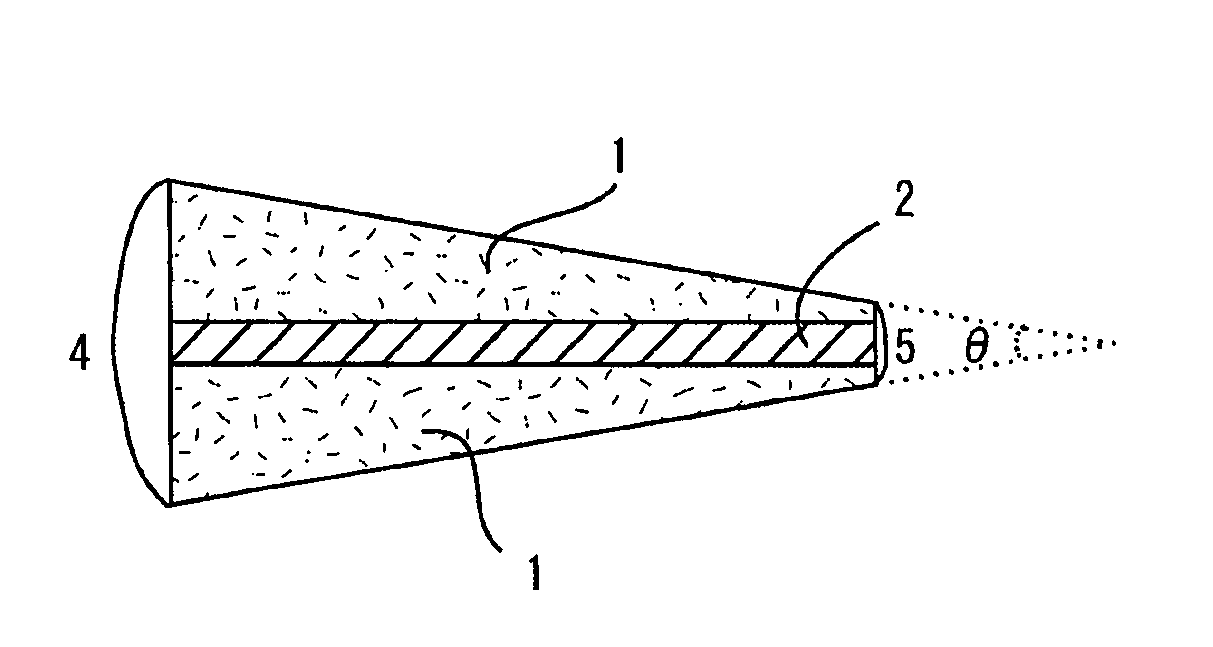Interlayer Film for Laminated Glass and Laminated Glass
a technology of laminated glass and interlayer film, which is applied in the field of interlayer film for laminated glass, can solve the problems of laminated glass having a particular problem of inferior sound insulation property, double reflection of instrument display in the visible field of the driver,
- Summary
- Abstract
- Description
- Claims
- Application Information
AI Technical Summary
Benefits of technology
Problems solved by technology
Method used
Image
Examples
example 1
(1) Production of a Sound-Insulating Layer
[0077]A sound-insulating layer was produced by adding 65 parts by weight of triethylene glycol di-2-ethylhexanoate (3GO) as a plasticizer to 100 parts by weight of a polyvinyl acetal resin having an acetylation degree of 12% by mole, 4 as the number of carbon atoms of the acetal group, and an acetalization degree of 65% by mole, sufficiently kneading the mixture by a mixing roll, and extrusion-molding the mixture. The thickness of the sound-insulating layer was as shown in Table 1.
(2) Production of a Protection Layer
[0078]A protection layer was produced by adding 38 parts by weight of triethylene glycol di-2-ethylhexanoate (3GO) as a plasticizer to 100 parts by weight of a polyvinyl acetal resin having an acetylation degree of 1% by mole, 4 as the number of carbon atoms of the acetal group, and an acetalization degree of 68% by mole, sufficiently kneading the mixture by a mixing roll, and extrusion-molding the mixture.
(3) Production of an In...
example 2
[0080]A sound-insulating layer was produced by adding 65 parts by weight of triethylene glycol di-2-ethylhexanoate (3GO) as a plasticizer to 100 parts by weight of a polyvinyl acetal resin having an acetylation degree of 1% by mole, 6 as the number of carbon atoms of the acetal group, and an acetalization degree of 65% by mole, sufficiently kneading the mixture by a mixing roll, and extrusion-molding the mixture. The thickness of the sound-insulating layer was as shown in Table 1.
[0081]Thereafter, a protection layer was produced and successively an interlayer film for a laminated glass was produced in the same manner as Example 1. The thickness of the interlayer film for a laminated glass and the wedge angle of the cross-section were as shown in Table 1. The cross-sectional shape was as shown in FIG. 2.
example 3
[0082]A sound-insulating layer was produced by adding 63 parts by weight of triethylene glycol di-2-ethylhexanoate (3GO) as a plasticizer to 100 parts by weight of a polyvinyl acetal resin having an acetylation degree of 1% by mole, 4 as the number of carbon atoms of the acetal group, and an acetalization degree of 78% by mole, sufficiently kneading the mixture by a mixing roll, and extrusion-molding the mixture. The thickness of the sound-insulating layer was as shown in Table 1.
[0083]Thereafter, a protection layer was produced and successively an interlayer film for a laminated glass was produced in the same manner as Example 1. The thickness of the interlayer film for a laminated glass and the wedge angle of the cross-section were as shown in Table 1. The cross-sectional shape was as shown in FIG. 2.
PUM
| Property | Measurement | Unit |
|---|---|---|
| thickness | aaaaa | aaaaa |
| thickness | aaaaa | aaaaa |
| thickness | aaaaa | aaaaa |
Abstract
Description
Claims
Application Information
 Login to View More
Login to View More - R&D
- Intellectual Property
- Life Sciences
- Materials
- Tech Scout
- Unparalleled Data Quality
- Higher Quality Content
- 60% Fewer Hallucinations
Browse by: Latest US Patents, China's latest patents, Technical Efficacy Thesaurus, Application Domain, Technology Topic, Popular Technical Reports.
© 2025 PatSnap. All rights reserved.Legal|Privacy policy|Modern Slavery Act Transparency Statement|Sitemap|About US| Contact US: help@patsnap.com


